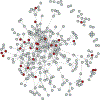Finding influential subjects in a network using a causal framework
- PMID: 36788358
- PMCID: PMC10423748
- DOI: 10.1111/biom.13841
Finding influential subjects in a network using a causal framework
Abstract
Researchers across a wide array of disciplines are interested in finding the most influential subjects in a network. In a network setting, intervention effects and health outcomes can spill over from one node to another through network ties, and influential subjects are expected to have a greater impact than others. For this reason, network research in public health has attempted to maximize health and behavioral changes by intervening on a subset of influential subjects. Although influence is often defined only implicitly in most of the literature, the operative notion of influence is inherently causal in many cases: influential subjects are those we should intervene on to achieve the greatest overall effect across the entire network. In this work, we define a causal notion of influence using potential outcomes. We review existing influence measures, such as node centrality, that largely rely on the particular features of the network structure and/or on certain diffusion models that predict the pattern of information or diseases spreads through network ties. We provide simulation studies to demonstrate when popular centrality measures can agree with our causal measure of influence. As an illustrative example, we apply several popular centrality measures to the HIV risk network in the Transmission Reduction Intervention Project and demonstrate the assumptions under which each centrality can represent the causal influence of each participant in the study.
Keywords: causal inference; centrality; contagion; interference.
© 2023 The International Biometric Society.
Figures




References
-
- Aral S and Walker D (2012). Identifying influential and susceptible members of social networks. Science 337, 337–341. - PubMed
-
- Bailey NT et al. (1975). The mathematical theory of infectious diseases and its applications. Charles Griffin & Company Ltd, 5a Crendon Street, High Wycombe, Bucks HP13 6LE.
-
- Banerjee A, Chandrasekhar AG, Duflo E, and Jackson MO (2013). The diffusion of microfinance. Science 341, 1236498. - PubMed
-
- Banerjee A, Chandrasekhar AG, Duflo E, and Jackson MO (2014). Gossip: Identifying central individuals in a social network. Technical report, National Bureau of Economic Research.
Publication types
MeSH terms
Grants and funding
LinkOut - more resources
Full Text Sources
Research Materials

